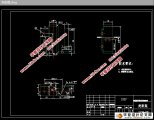电机碳刷架冷冲压模具设计(开题报告,中期检查表,论文设计说明书14800字,CAD图17张)
摘 要:冷冲压模是广泛运用的模具之一,种类包括冲孔模、落料模、弯曲模、拉深模等,近年来冷冲模的应用越来越广泛。冷冲压具有成本低,产品质量稳定,能加工多种性能,状态的零件。同时它的应用和普遍也受到模具寿命和生产安全等方面的制约。本文作者从工艺的合理性出发,分析了电机碳刷架的结构,精度特点,以及在加工过程中的控制点,然后在满足加工精度的基础上充分考虑节约成本确定了电机炭刷架最优化的冲裁加工工序;紧接着通过熟悉各类模具的加工特点及内部结构,完成模具总体结构分析;随后作者进行毛坯尺寸、排样、工序尺寸、冲压压力、压力中心、模具工作部分尺寸等工艺计算,力争以最好的性价比设计了模具各零件的结构及装配关系,在此基础上确定模具的外形,完成了装配图和非标准的零件图。最后确定压力机类型及主要参数。
关键词:冲孔模;落料模;弯曲模;冲压压力;压力机
The Cold Stamping Die Design of the Brushless Motor
Abstract:Cold punching mould that is used extensively among the all kinds die ,including punching hole mould, blanking die, bending mould, crooked model, conical die etc., The application of the cold punching die is more and more extensive in recent years. It is with low costs that there is the cold punchingly, product quality is steady, can process many kinds of performance , Part of the state. Its application and generallying receive the restriction in life-span of the mould and production safety,etc. at the same time . Author of this text proceed from rationality of the craft, analyse electrical machinery charcoal pastes up the structure of the shelf , Precision characteristic, and the control point in the course of processing, Consider and economize cost confirm electrical machinery charcoal brush blanking that shelf optimizes most process the process fully on the basis of satisfying the machining accuracy; And then pass the processing characteristic familiar with all kinds of moulds and inside structure, Finish the ensemble architecture analysis of the mould ; Author carry on blank size, arrange kind, process size, punching pressure, pressure in the center afterwards, mould work some size,etc. craft calculate, Strive to design the structure of every part of the mould and assembly relation with the best cost performance, Confirm the appearance of the mould on this basis, has finished the installation diagram and non-standard part picture. Confirm the type of the press and main parameter finally.
Keyword: punching hole mould;blanking die;bending mould;punching press;punching machine
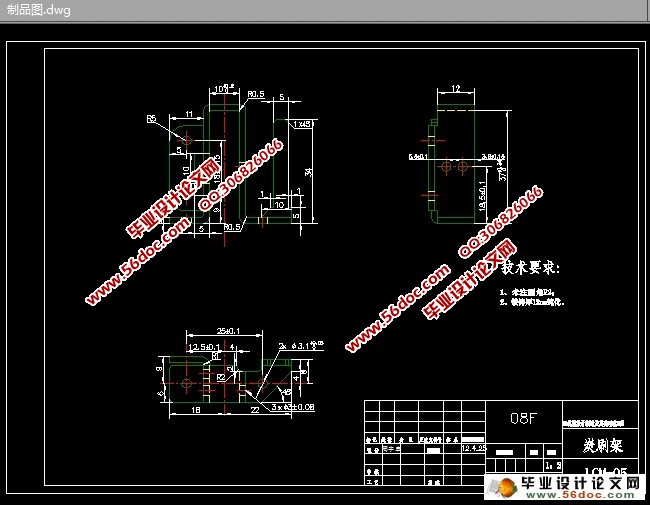
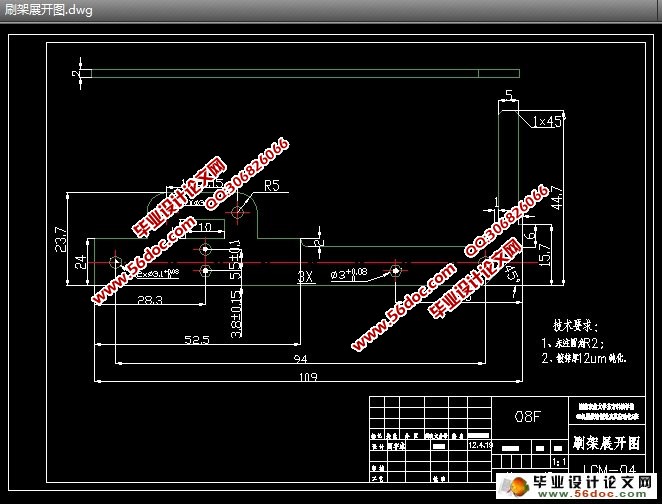
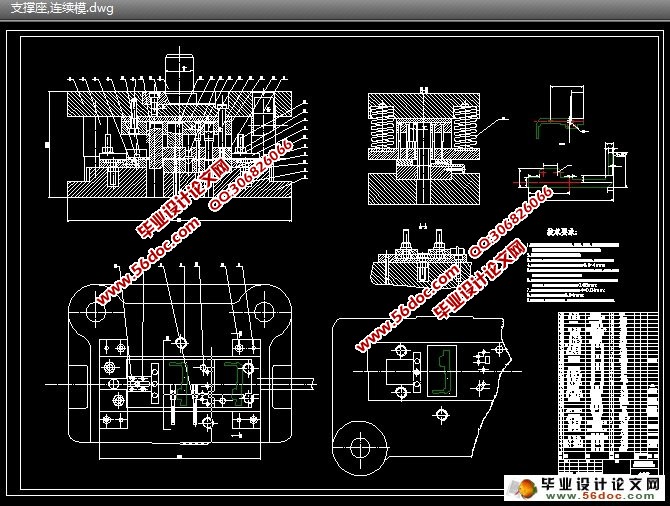
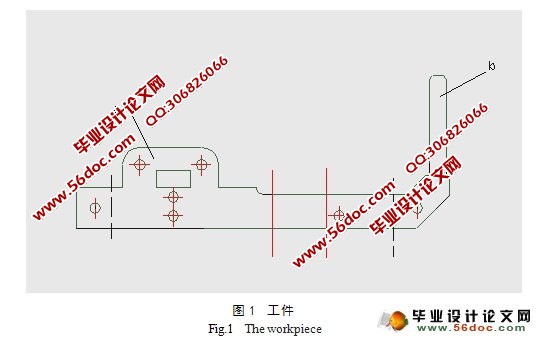
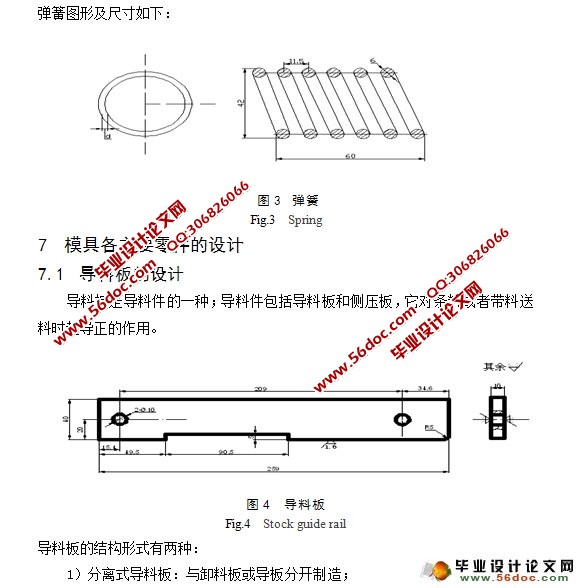
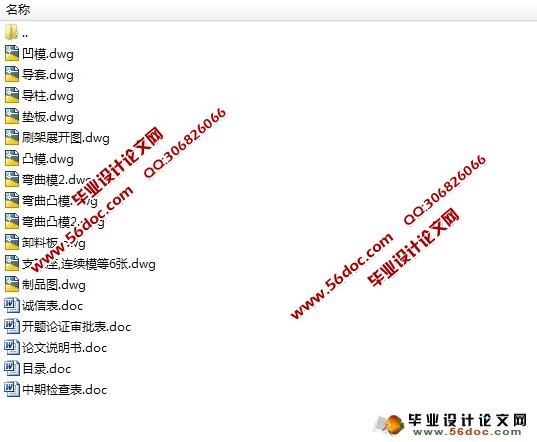
目 录
摘要 …………………………………………………………………………………………1
关键词 ………………………………………………………………………………………1
1 前言 …………………………………………………………………………………… 2
1.1 选题研究意义 ………………………………………………………………… 2
1.2 国内外研究现状 ……………………………………………………………… 3
2 确定工件的工序方案 ………………………………………………………………… 5
3 主要工艺参数计算 …………………………………………………………………… 6
3.1 长度方向上的计算 …………………………………………………………… 6
3.2 宽度方向上的计算 …………………………………………………………… 6
3.3 搭边及排样 …………………………………………………………………… 6
3.3.1 排样 …………………………………………………………………… 7
3.3.2 搭边 …………………………………………………………………… 7
3.4 计算冲裁力 …………………………………………………………………… 7
3.5 确定压力中心 ………………………………………………………………… 9
3.6 冲压设备的选择 ……………………………………………………………… 9
4 主要工作部分尺寸计算 ……………………………………………………………… 9
4.1 冲裁件的工艺性 ………………………………………………………………10
4.1.1 冲裁体的尺寸精度和断面粗糙度…………………………………… 10
4.2 冲裁间隙 ………………………………………………………………………10
4.3 凸凹模工作部分尺寸与公差 …………………………………………………10
4.3.1 冲孔部分刃口计算 ……………………………………………………10
4.3.2 用配合加工法的尺寸计算 ……………………………………………10
4.4 切断部分刃口计算 ……………………………………………………………11
4.5 第一道弯曲模工作部分尺寸计算 ……………………………………………12
4.5.1 最小弯曲半径 …………………………………………………………12
4.5.2 弯曲件的直边高度 ……………………………………………………12
4.5.3 弯曲件孔边距离 ………………………………………………………14
4.5.4 弯曲件的精度 …………………………………………………………14
4.6 弯曲件的回弹 …………………………………………………………………14
4.6.1 影响回弹的因素 ………………………………………………………14
4.6.2 回弹角的大小 …………………………………………………………14
4.6.3 减少回弹角的措施 ……………………………………………………14
4.6.4 凸模圆角半径 …………………………………………………………15
4.6.5 凹模圆角半径 …………………………………………………………15
4.6.6 凸凹模工作部分的尺寸与公差 ………………………………………15
4.7 弯曲模的间隙 …………………………………………………………………15
5 模具总体设计 …………………………………………………………………………16
5.1 模具类型的选择 ………………………………………………………………16
5.2 确定送料方式 …………………………………………………………………16
5.3 凸凹模工作部分尺寸与公差 …………………………………………………16
5.4 卸料、出件方式的选择 ………………………………………………………16
6 卸料零件计算 …………………………………………………………………………16
6.1 卸料弹簧的选择 ………………………………………………………………16
7 模具各主要零件的设计 ………………………………………………………………17
7.1 导料板的设计 …………………………………………………………………17
7.2 冲孔凸模的设计 ………………………………………………………………18
7.2.1 冲孔凸模的尺寸及形状 ………………………………………………18
7.2.2 凸模的固定形式 ………………………………………………………18
7.2.3 凸模长度的确定 ………………………………………………………18
7.2.4 凸模强度的校核 ………………………………………………………19
7.3 压弯凸模的设计 ………………………………………………………………20
7.4 凹模的设计 ……………………………………………………………………21
7.4.1 凹模的刃口形式 ………………………………………………………21
7.4.2 凹模的外形及尺寸 ……………………………………………………21
7.5 模具闭合高度的校核 …………………………………………………………22
7.6 卸料螺钉的设计 ………………………………………………………………22
7.7 弹性卸料板的设计 ……………………………………………………………23
7.8 模架的选取 ……………………………………………………………………23
7.9 导柱、导套的选择 ……………………………………………………………23
7.10 导料销的选择 ……………………………………………………………… 23
7.11 螺钉及销钉的选择 ………………………………………………………… 23
8 最后一道弯曲模设计 …………………………………………………………………25
8.1 弯曲件的工艺性 ………………………………………………………………25
8.1.1 最小弯曲半径 …………………………………………………………25
8.1.2 弯曲件直边高度 ………………………………………………………25
8.1.3 弯曲件的精度 …………………………………………………………25
8.2 弯曲件的回弹 …………………………………………………………………26
8.2.1 影响回弹的因素 ………………………………………………………26
8.2.2 回弹角的大小 …………………………………………………………26
8.2.3 减小回弹的措施 ………………………………………………………26
8.3 弯曲力的计算 …………………………………………………………………26
8.3.1 弯曲力的大小通常采用的经验公式 …………………………………26
8.3.2 顶件力计算 ……………………………………………………………27
8.3.3 弯曲时压力机公称压力的确定 ………………………………………27
8.4 弯曲模的间隙 …………………………………………………………………27
8.5 弯曲模工作部分尺寸计算 ……………………………………………………27
8.5.1 凸模圆角半径………………………………………………………… 27
8.5.2 凹模圆角半径及凹模深度 ……………………………………………27
8.5.3 凸凹模工作部分的尺寸公差 …………………………………………28
8.6 压力机的选择 …………………………………………………………………28
8.6.1 压力机各参数 …………………………………………………………28
8.7 模架的设计与有关尺寸 ………………………………………………………28
8.8 顶出机构 ………………………………………………………………………29
8.8.1 顶板与凹模的配合 ……………………………………………………29
8.8.2 顶板的尺寸 ……………………………………………………………29
8.9 模具的安装 ……………………………………………………………………29
8.9.1 模具安装的注意事项 …………………………………………………29
8.9.2 模具安装的一般次序 …………………………………………………29
9 结论 …………………………………………………………………………………30
参考文献 ……………………………………………………………………………… 30
致谢 …………………………………………………………………………………… 31
附录 …………………………………………………………………………………… 32
附录
附录1:A0图纸1张
附录2:A1图纸1张
附录3:A2图纸3张
附录4:A3图纸8张
附录4:A4图纸4张
|
